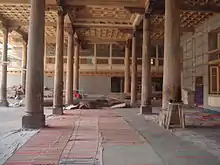| Khanqah-e-Mualla Noorbakshia Khaplu Bala | |
|---|---|
خانقاہ معلیٰ نوربخشیہ خپلو بالا | |
 Inside view | |
| Religion | |
| Affiliation | Noorbakshia, Islam |
| Location | |
| Location | Khaplu Bala, Pakistan |
 Location in Pakistan | |
| Geographic coordinates | 35°09′25″N 76°20′43″E / 35.15703°N 76.34522°E |
| Architecture | |
| Type | Mosque |
| Style | Tibetan, Iranian, Mughal |
| Date established | 1370 |
| Construction cost | 20 million |
| Capacity | 3000 within the adjoining grounds areas, |
Khanqah-e-Mualla Noorbakshia Khaplu Bala (Urdu: خانقاہ معلیٰ نوربخشیہ خپلو بالا) is the largest Khanqah[1] built by mud and wood in the region of Gilgit Baltistan. It is located in Khaplu and was built by Mir Mukhtar Akhyar,[2] a Sufi master of Nurbakshi Order around 400 years ago. It is one of the oldest mosques in the Baltistan region, and is one of the areas most famous landmarks and a major tourist attraction.
See also
References
- ↑ Stefano Bianca (2005). Karakoram: Hidden Treasures in the Northern Areas of Pakistan. U. Allemandi for Aga Khan Trust for Culture, 2005 - Art - 322 pages. p. 154. ISBN 9788842213307.
- ↑ Journal of the Pakistan Historical Society, Volume 37, Part 1. Pakistan Historical Society. 1989. p. 83.
This article is issued from Wikipedia. The text is licensed under Creative Commons - Attribution - Sharealike. Additional terms may apply for the media files.

